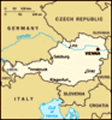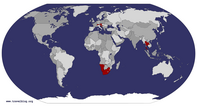Advertisement
Published: September 5th 2020
After having packed our little VW Golf to the max, we drove from Wil through parts of Austria and Slovenia to Hrvatska (Croatia). We were planning to stay at least 4 to 5 weeks in Croatia, establishing our Mediterranean base camp in Vodice, a town near Sibenik, in Central Dalmatia, courtesy of Ana and Tomislav and her families. More of that later......
But first we wanted to see some places in Austria and Slovenia and catch up with friends there. Austria is full of history and natural beauty, so we had to choose. We picked the topic Danube River, Salzburg and Salzkammergut, the lovely countryside South of Salzburg, famous for its mountains, lakes and small authentic villages.
The Danube or Donau (in German) is Europe's second largest river (after the Volga) measuring 2'850km in length. Its source can be found in the Black Forrest in Germany and its river mouth is in Romania, when the mighty river flows into the Black Sea. It passes through 10 countries, and cities like Vienna, Budapest and Belgrade have been build on its shores. 32 main tributaries flow into the Danube along its way, making it a major waterway for shipping and transportation.
The Danube was an important border for the Roman Empire protecting it from the nomadic tribes from the Eastern plains. If you want to understand the cultural significance of the Danube go to Vienna and listen to the music of the Strauss (father and sons) composers.
We followed the Danube from Passau to Krems, not on the many wine ships, but boringly in our car. The landscape transforms from rugged hills and a winding Danube to a slow flowing mighty and wide Danube surrounded by vineyards on both sides of it shores. The area of Krems is indeed the most famous white wine producing area of Austria, As Nenad needed to drive he appreciated the Habsburg invention of white wine spritzer, or "Gemischter" as they call this drink also; a combination of white wine and sparkling water, as most of you already have experienced, I am sure. Especially impressive we found the area of the Schloegener Schlinge, where the Danube makes sharp turns around steep mountains, creating a unique sight. Later travelling down stream the river from the Schloegener Schlinge one reaches the area called Wachau, and Krems its main city. The Wachau is one of Austria's most established


and notable wine regions, specializing in dry wines made from Riesling and Grüner Veltliner. Despite its fame however the wine region accounts for only 5% of the Austrian wine production. After a brief visit of the Waldviertel, a wast forest and hiking area at the Czech Austrian border, we following the Danube towards Linz passing through Mauthausen, a town which became famous for all the wrong reason. In March 1938 after the annexation (Anschluss) of Austria by the Hitler's regime, a concentration camp was built outside this town. It is estimated that app 300'000 Jews and "enemies" of the NSDAP (Hitlers party) and German NAZI regime were killed on this site. Our visit was brief, sad and we left with the unanswered question why all this needed to happen.
The city of Salzburg is the fourth largest city in Austria home to 150'000 inhabitants. The city is divided by the Salzach River, with medieval and baroque buildings of the pedestrian Altstadt (Old City) on its left bank, facing the 19th-century Neustadt (New City) on its right. The Altstadt is the birthplace of famed composer Mozart. Nenad does not like much Salzburg, as it tries so desperately to copy Vienna,

 Grein on the Danube
Grein on the Danube
a cute place to stop for foodnever however reaches Vienna's multiculturalism, cultural diversity or even classical music appeal. Mozart has worked and become famous in Vienna, don't forget that! Salzburg's historic center is renowned for its Baroque architecture and is one of the best-preserved city centers north of the Alps, listed as a UNESCO World Heritage Site in 1996. As so many cities in this region also Salzburg's origins date back to the Romans, who named the city Juvavum. The Salzburg Festival is a famous music and theater festival that attracts visitors during the months of July and August each year. Established in 1920 one highlight is the annual performance of the play Jedermann (Everyman) by Hugo von Hofmannsthal. Even Covid did not prevent the festival in 2020 and Jedermanns 100th anniversary showing took place. Unfortunately we did not manage to get tickets.
Travelling trough the Salzkammergut towards Slovenia exposed us to some of the most wonderful corners of Austria. Passing along the romantic Mondsee to Fuschl where the World Head Office of RedBull is situated. Austrian entrepreneur Dietrich Mateschitz was inspired by an existing energy drink named Krating Daeng, which was first introduced and sold in Thailand by Chaleo Yoovidhya. He took this idea,
modified the ingredients to suit the tastes of Westerners and in partnership with Chaleo, founded Red Bull in 1987. The rest we all know, as RedBull is, like it or not, visible everywhere. St. Wolfgang on the lake of Wolfgang (Wolfgangsee) is another of the legendary towns of this region. Made famous through an operetta and a movie about the Hotel Weißes Rössl (White Horse Inn), it has huge popularity with German tourists of mature ages. Not far from St Wolfgang lies the town of Hallstatt. It has 574 inhabitants but registered in 2018 a record of 900'000 tourists !!! who visited this picturesque UNESCO heritage village. This overtourism was mainly due to masses of Chinese visitors. Why? Because there is a replica of this village in China called Hallstatt China (矿·哈施塔特). It is a housing development in Luoyang, Boluo County, China. The housing project was built by the China Minmetals mining company. Made famous in China, most Chinese visitors must of course see the original when coming to Europe. Reaching the southern part of the Alps required the crossing of a mighty mountain pass, the Grossglockner High Alpine Road. It is the highest surfaced mountain pass road in Austria.
It connects the Salzkammergut with Carinthia. The Pass has an altitude of 2,504 m. Recommended only to experienced mountain pass drivers, the road is named after the Grossglockner, Austria's highest mountain. The toll is EUR 35.- !!!, As we headed towards Croatia, Austria, Italy and Slovenia were starting to call back their tourists from Croatia due to rising number of Covid cases in Nenad's home country, especially in the tourist destinations of Dalmatia and imposing testing and quarantine measures for returning citizens. Great, Nenad thought, so we will have less crowded places, safer altogether. We continued driving South......
Slovenia is a small country, which was one of the 7 republics of Yugoslavia before this country broke up in a political and military struggle in the early 1990's. With over 2 million inhabitants only it is one of the smallest members of the European Community. Although 80% of its population is of Slavic origins, it is characterized by many features of Germanic culture and lifestyle. Having been an integral part of the Habsburg Empire for centuries, the architecture, food and social interactions bare similarities to that of South Eastern Austria. Even its language, whilst Slavic, borrows many words from the
Habsburg vocabulary. Ljubljana is Slovenias capital and largest city with 300'000 inhabitants. It's known for its university population, green spaces and appeal to art and architecture. The curving Ljubljanica River, is lined with outdoor cafes. It divides the city's old town from its commercial hub. Ljubljana has many museums, including the National Museum of Slovenia, displaying historic exhibitions, and the Museum of Modern Art, home to 20th-century Slovene paintings and sculptures. We did not stay long in this city, so could not enjoy all what it has to offer. But a tasty lunch and a stroll through the old town gave us a good feeling of the city, where history and contemporary life mix in a natural way. Bled is the other worthwhile place to visit in Slovenia, which we did. Bled, a Slovenian resort town in the foothills of the Julian Alps, is set along the glacial Lake Bled. On a cliff overlooking the lake is the 11th-century Bled Castle, which houses a museum, chapel and printing press. Atop a small island in the lake's center is the Pilgrimage Church of the Assumption of Maria, with its steep staircase and bell tower. Since we have seen in past weeks
many examples of mountains, lakes and historic sites in Austria and Switzerland, our visit to Bled was rather brief.
Finally we arrived in Nenad's home country, Croatia, crossing the border in Koper, Slovenia's main harbor. The very limited access of Slovenia to the Adriatic Sea causes always diplomatic friction between Zagreb and Ljubljana, something Brussels (EU capital) is not appreciating. Actually Nenad's home country of birth was Yugoslavia's Republic of Croatia, where he spent his childhood. A terrible war in the early 1990's tore Yugoslavia apart, but managed to give the Croats their independence. Nenad will not elaborate here on the rather complex history of Croatia. For those who are interested in the subject, he recommends the book "Croatia, A Nation Forged In War", by Marcus Tanner. Or meet Nenad buy him a good bottle of wine and have time to listen ......
Advertisement
Tot: 0.179s; Tpl: 0.013s; cc: 15; qc: 50; dbt: 0.1249s; 1; m:domysql w:travelblog (10.17.0.13); sld: 1;
; mem: 1.2mb


























